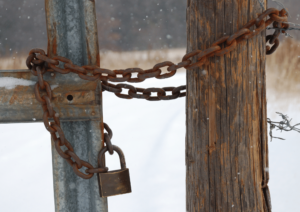 Use this guide from our Conservation Development Officer, Helena Jaeschke, to help you when closing up your museum for winter, to ensure your collections are safe and well looked after.
Use this guide from our Conservation Development Officer, Helena Jaeschke, to help you when closing up your museum for winter, to ensure your collections are safe and well looked after.
Drains & Floods
Walk around the building and check that all drains are clear and guttering is swept free of leaves. Are there any areas prone to leaks? Prepare for rainfall and make sure you have buckets, mops, a wet/dry vacuum and polythene sheeting available. Can you remember the flood or leak procedures in your Emergency Plan? A good time to check all the contact details are up to date.
Batteries
Do your data loggers need new batteries (most last 2-3 years)? Do any other items have batteries that need checking or replacing? Smoke alarms? Emergency lights? Torches in the emergency kit? Have you checked your data? Now is a good time to download data from the data-loggers and reset them.
Heating
Does the museum have low level heating to keep it frost-free for winter? Aim to keep the temperature low and stable, especially at night, to stop the relative humidity fluctuating. High humidity encourages mould growth, corrosion, pest activity and many forms of deterioration.
Light
While the museum is closed, there is no point allowing objects to be damaged by light when no-one can see them. Make sure any areas where objects are exposed (on display or unboxed in storage areas) are not open to daylight – keep blinds and blackout curtains closed, or cover cases and shelves with clean Tyvek or cotton sheets.
Hanging Items
Take down any hanging items and check the fixtures are still strong and in good condition. Replace any that look corroded or strained. Never suspend items using fishing line.
Security
Make sure alarms are working and have space to record images. Make sure you know who has keys. Check for any missing keys. Keep interior keys securely locked up. Let emergency services know if the building will be unattended for long periods.
Dust
Dust is a good food base for mould and pests, and with the higher humidity in winter it can set like concrete on surfaces and encourage corrosion. Wipe down smooth, strong surfaces such as shelves, boxes, cupboards and walls with a clean microfibre cloth. Clean smoke alarms too. Use a soft brush to sweep dust off robust objects into the nozzle of a vacuum which is protected with a piece of soft net or tights, held on with a rubber band. Be careful of raised or rough surfaces and don’t wipe decorated or powdery surfaces of objects. Never wipe or brush gilded surfaces!
Cover
After dusting, cover objects that are not in boxes or dust-free cases with a light cover of acid-free tissue paper, Tyvek fabric or even clean, light cotton fabric. Don’t cover items directly with polythene sheet or bubble-wrap as high humidity can get trapped underneath – use acid-free tissue next to the object.
Pests
Pests may have moved into the museum during the summer to lay their eggs, so check pest traps every two months during the winter. A good cleanup will remove a lot of food sources for them. Make sure you have a plan of your traps and mark any pests present with a felt-tip pen dot so that you can quickly spot new arrivals.
Empty all waste bins before you leave. If you are unsure about any pests you find (or if you spot mould in the museum) don’t hesitate to get in touch!
Dehumidifier
Time to give your dehumidifier a bit of TLC too – clean or replace the filter, wash the tank and wipe down the outside. Make sure it is set to keep the relative humidity at 50% and that it will be emptied regularly. If it is difficult to arrange this, it may be better to fit a hose and place the unit so that it can drain continuously. Keep your dehumidifier running all year.
